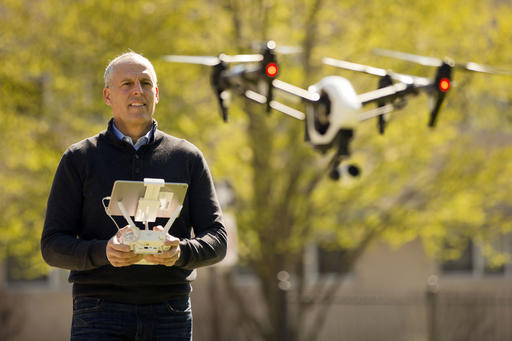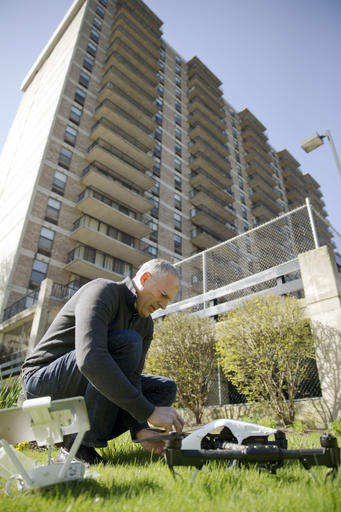New vistas open up at small businesses that use drones

In this Thursday, April 14, 2016, photo, DroneLinx CEO Steve Metzman operates a drone to make videos and still images of an apartment building, in Philadelphia. DroneLinx, a service based in New York, takes shots of cellphone towers, bridges, oil rigs and utility lines that are difficult to get careful inspections of, Metzman says. (AP Photo/Matt Rourke)
NEW YORK — That drone flying around a suburban house might not belong to a wannabe pilot — it may be a tool that’s become indispensable for a small business.
Many small companies have either built their business around drones or use them to do tasks they previously accomplished by regular planes and helicopters. The unmanned aircraft also take the place of humans who might use scaffolding or navigate difficult terrain to get a close look at a structure or damage from a disaster. Drones, whose prices range from under $100 into the thousands of dollars, can be cheaper, faster and safer ways to make inspections and take photos and videos.
Mark Stoner’s chimney repair company uses them to assess the work a potential customer needs without rigging a scaffold or having a worker climb onto a sharply-angled roof.
“We started using them in dangerous or difficult situations where you can’t get a person very easily,” says Stoner, co-founder of SirVent in Nashville, Tennessee.
Cameras on the company’s three drones can show cracks or other damage and peer inside a chimney. The drones are controlled by a smartphone or a tablet computer.
“It’s just like playing a video game. They’re very easy to fly around,” Stoner says.
Trending now
The Federal Aviation Administration has issued more than 5,000 exemptions, or permits, for commercial drone use since it began regulating non-recreational use of drones in September 2014. Companies must file petitions with the FAA to be allowed to use drones, or as the agency calls them, unmanned aircraft systems.
Large companies also use drones in the course of their work — Amazon.com CEO Jeff Bezos has said he hopes to deliver packages using drones. But because drones have only started getting notice the past few years, they’re still something of a novelty. Companies can tout their ability to use drones in advertising or when bidding on projects.
Meares Auction Group, which auctions real estate and other property, has posted videos of properties shot by drones on its website, including one that had sweeping vistas of a house and its grounds and gave viewers a sense of what it would be like to go up the property’s long driveway.
“Drones are the flavor of the month now,” says Darron Meares, CEO of the Pelzer, South Carolina-based company.
Companies attracted to drones’ versatility and in many cases their ability to help cut costs are getting creative about how to use them, says Regenia Sanders, a management consultant with SSA & Co. in New York. For example, using drones in a warehouse to check on inventory may allow a company to cut its labor costs. But many companies also may not know yet if a drone makes economic sense, she says.
“People are just trying to look at possibilities for how drones can be used, and then think about the cost part,” she says.

In this Thursday, April 14, 2016, photo, DroneLinx CEO Steve Metzman prepares his drone to make videos and still images of an apartment building, in Philadelphia. DroneLinx, a service based in New York, has a variety of clients who want aerial photos or videos but don’t want or need their own aircraft. (AP Photo/Matt Rourke)
Going where people can’t
For some companies, just being able to do their work more easily is reason enough to use drones. For example, they come in handy when toxic spills from rail cars or pipelines occur in hard-to-reach areas and thousands of gallons of leaked chemicals or fuel prevent crews from assessing the damage and starting a cleanup.
“We’ve had several of those where they don’t allow anyone in because of health and safety issues,” says Bryan Martin, emergency response director at Superior Environmental Solutions, a Cincinnati-based company with offices in Ohio, Pennsylvania, Kentucky and Michigan that cleans up spills.
Superior began using a drone three years ago, equipping it with high-definition cameras that show the extent of the spills and equipment that measures air quality. The drones send that data wirelessly to Martin’s teams so they can determine whether it’s safe to start approaching a site.
“Usually they have to go by vehicle and find access points or get a helicopter, but we can just send a drone,” he says.
The drone also helps officials determine whether the area around a spill must be evacuated, he says.
A company that owns a drone is more nimble because it doesn’t have to rely on private plane or helicopter services, says Brian Webster, executive vice president with KWA Construction in Addison, Texas.
“You have to work with their schedule,” Webster says. With its own drone, his company can take as many pictures of its projects as it wants — and whenever it wants.
Better, cheaper videos and photos
C.L. Burks Commercial Roofing uses a drone for progress reports to owners and managers of the buildings it works on, including high-rises and shopping centers.
“In the past, we used a company with a plane and a camera, and that gets pretty expensive,” says Jut Carnes, a vice president of the Alpharetta, Georgia-based company. Burks was working on nine projects throughout the Southeast and Puerto Rico, and it would have been too costly to shoot video to all its clients at once without a drone. It costs $500 to shoot photos of one building from a plane.
Cameras on drones take more than photos or video. Rotor Air Cam, a Plainview, New York, based drone operator, uses equipment that help create topographical maps and 3D models of terrain, co-owner David Sanders says. The company, whose clients include oil and gas producers and other industrial companies, is also exploring the use of equipment that can detect gas leaks around oil wells.
Some companies have been launched purely to fly drones for a variety of customers who want aerial photos or videos but don’t want or need their own aircraft. DroneLinx, a service based in New York, takes shots of cellphone towers, bridges, oil rigs and utility lines that are difficult to get careful inspections of, CEO Steve Metzman says. His company’s surveying services start at $2,500.
Metzman, a commercial helicopter pilot as well as a registered drone operator, also has local law enforcement agencies for clients.
“They’re using drones to get immediate aerial views on crime scenes,” he says.
But some companies find drones don’t do better than full-size aircraft. Hahn Estate, a vineyard in Soledad, California, has experimented with using drones to check on the progress of the grape crops rather than the planes it has used for years. With 1,100 acres to cover, it looks like a drone is too small and takes too long to survey all the vines.
“A regular plane can cover so much more ground and do it more efficiently,” says Andy Mitchell, a winemaker with Hahn. TVJ